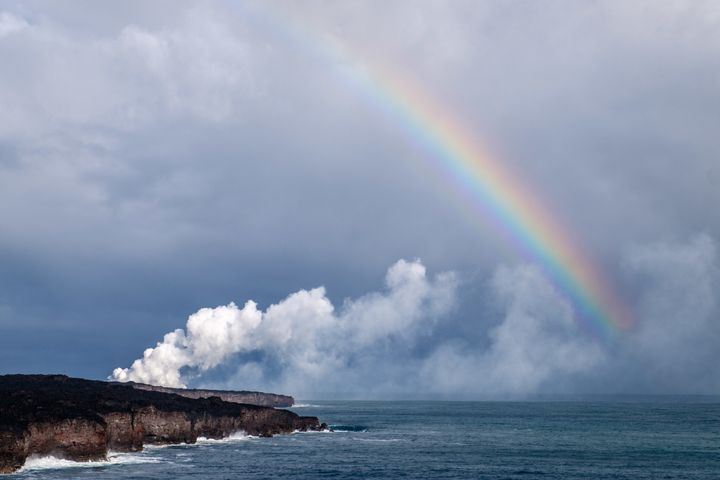
Where the lava meets the icy Pacific seas in Hawai’i Volcanoes National Park... and fittingly, a rainbow.
Over the course of 70 million years, lava pouring from active volcanoes in the heart of the Pacific Ocean have formed a chain of islands full of mystique and natural beauty. It is America's favorite tropical playground – a land of paradise beaches, great food, warm people, a vibrant cultural history, and spectacular scenery – and it would cease to exist without the volcanoes that grumble beneath our feet.
Hawai’i Volcanoes National Park on the Big Island is the great protector of five volcanoes that gave birth to the islands themselves. Kīlauea and Mauna Loa are the two that remain active, continuously spewing molten rock which hardens to form a dynamic universe of wild terrain, tubes, caves, and fracture lines where lava flows until it reaches high ground. Across the terrestrial landscape, steam vents hiss gaseous breath from deep inside of the planet, creating an environment that feels as if it hangs in the balance between our world and another.
The national park is located on the south side of the island, stretching from the shores of the Pacific Ocean to the summit of Kīlauea rising to 4,000 feet. Across 333,00 acres there are endless areas to explore full of craters, desert, and tropical rainforest.
This article is dedicated to highlighting some of the top spots in Volcanoes, listed in no particular order. As with every national park adventure, we recommend an immediate first stop at the visitor center to get up-to-date info on trails, eruption-related closures, a schedule of ranger-guided park activities, and of course, a report on where best to see present volcanic activity.
1. Crater Rim Drive
To get an introductory taste of Hawai’i Volcanoes, hop in your car and head out on an auto-expedition of Crater Rim Drive and Chain of Craters Road, the two main thoroughfares in the park.
Chain of Craters Road stretches 19-miles from the Makaopuhi Crater to the Kalapana coast descending 3,700 feet.
Crater Rim Drive skirts the Kilauea Caldera and passes through 11-miles of jungle and desert ecosystems.
There are many viewpoints to stop at along both roads bringing you face-to-face with popular sites in the park, including the Kīlauea and Kīlauea Iki overlooks, the Ha'akulamanu crater observation deck at the Jaggar Museum, the beloved Thurston Lava Tube, and the Puʻu Puaʻi overlook. There are plenty of areas to explore on foot as well, so bring water, sunscreen, sturdy shoes, and don't forget your camera! Aside of volcanic features, jungle, desert, and sky-shows of rainbows, sunsets, wild clouds and the like, the off-road environment is a ripe habitat for families of the endangered Hawaiian goose, called Nēnē.
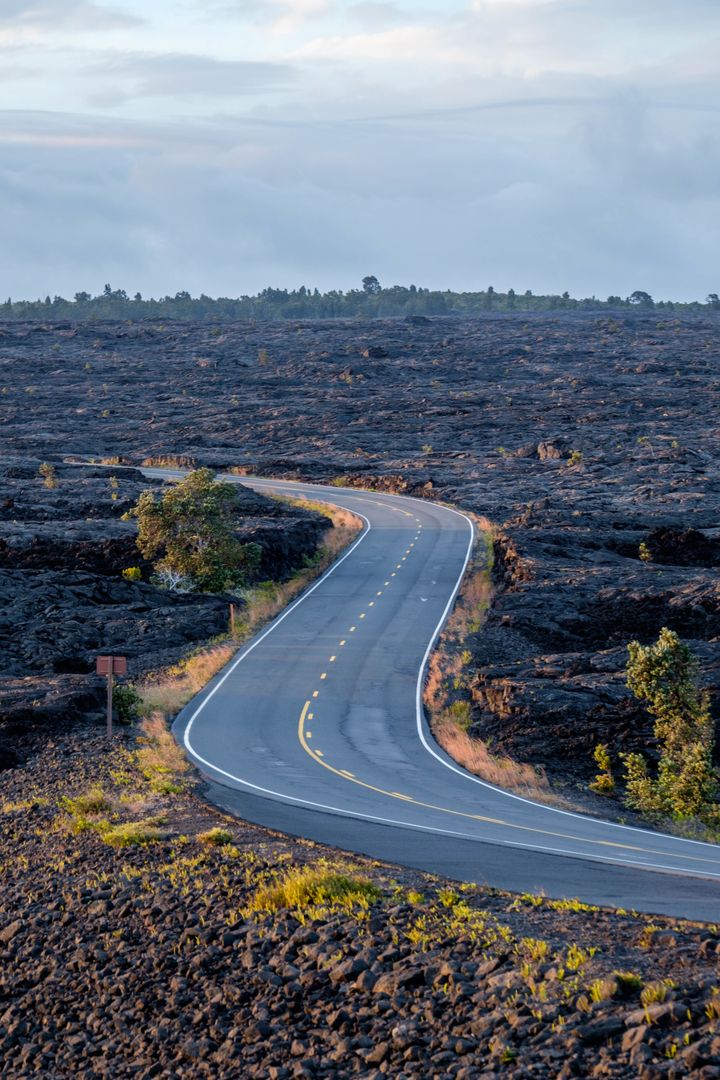
Chain of Craters Road winds from the high points in the park to the sea.
2. Jaggar Museum
For all things volcano related, head to the Jaggar Museum for a superb overview of Hawai'i's active volcanoes. The observation deck provides the closest proximity to an eruption point (presently about 100 feet.) There are scopes positioned on the deck allowing for magnified views and knowledgable rangers nearby (during operating hours) to explain important facts and ideas about the area. We recommend exploring the area during the day time and also at night to get a varied glimpse of Pele's masterwork. Pele, if you aren't familiar, is the mythical Hawai'ian goddess of fire, lightning, wind, and volcanoes. The main crater, Halema'uma'u, is her home.
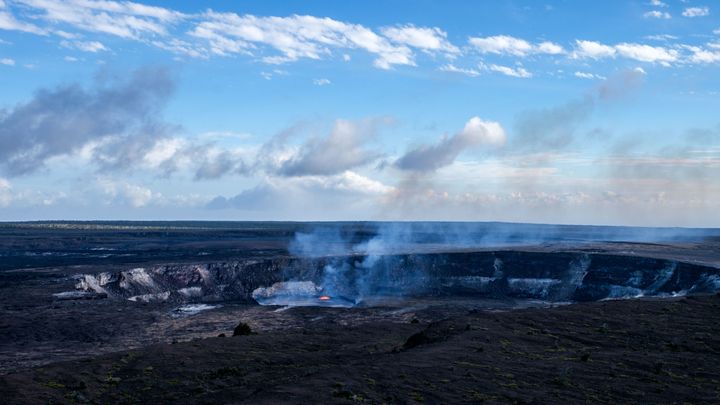
Halema'uma'u, Kīlauea's main crater during the daytime as seen from the observation deck at the Jaggar Museum.
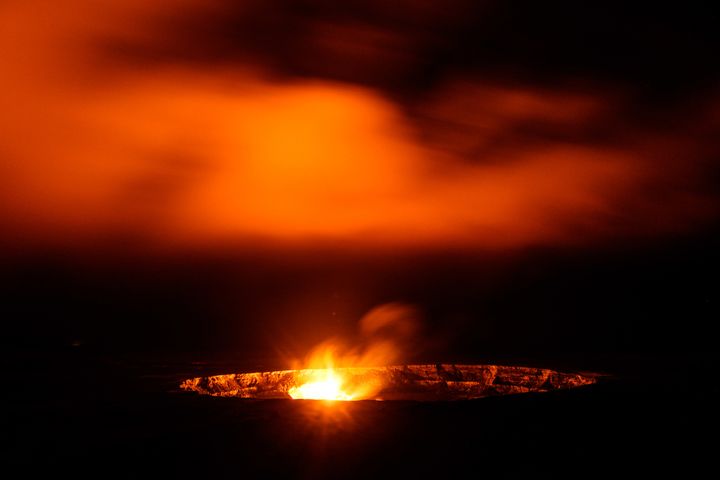
Halema'uma'u, Kīlauea's main crater during the daytime as seen from the observation deck at the Jaggar Museum.
3. Kīlauea Iki
This is one of those hikes that stops you in your tracks. Lush tropical rainforests, native flora and fauna species, a steaming black landscape – Kīlauea Iki has it all and then some.
The location is home to the Pu‘u Pua‘i cinder cone, which spewed lava 1,900 feet into the sky when it erupted in 1959 after a 90 year slumber. For five weeks, 17 episodes occurred, flooding the crater with molten rock creating a lake of lava 400-feet deep.
Today, you can walk across the hardened lava bed on this awesome hike. In the space of about 3 hours crossing 4 miles, you will explore a dynamic rainforest on the slopes of the crater, steam vents, cinder cones, and spatter cones on the crater floor, with ahu (cairns, or stacked rocks) guiding your way to the other side.

After a 400 foot descent from the crater rim, we started across the steaming crater...
4. Hōlei Sea Arch
Sometime during the last 100 years, the Pacific Ocean revealed to the Big Island a natural sea arch formation at the end of Chain of Craters Road – a must capture photograph when visiting the park. The basalt arch is estimated to be 550 years old, a gift from Kīlauea to the mighty Pacific Ocean. Standing above it can be a little unnerving (particularly for those who fear exposure) as the seawall drops 90-feet into a rocky shore. This must see stop on Chain of Craters Road is just steps away from an easily accessible parking area, and is a one-of-a-kind feature in the national park.
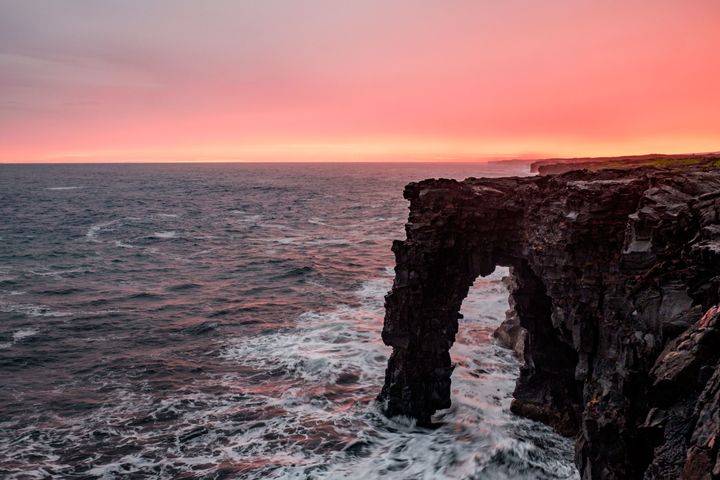
The Hōlei Sea Arch warmed at sunset.
5. Hilina Pali Overlook
As you make way toward the ocean on Chain of Craters Road, there is a turnoff to the Hilina Pali Overlook where you can take in sweeping panoramic views across a coastal wilderness in the heart of Volcanoes’ backcountry. The drive to the overlook from the main park road turn off is 3.5-miles each way on a one-lane road, allowing time to view a more rugged side of the Hawai'ian landscape. A visit to this area shows adventurers an unusual and diverse terrain passing through grasslands, arid desert, volcanic landscape, island wildflowers, and groves of ohi’a trees. This area also tends to be uncrowded which makes it that much more awesome to explore.
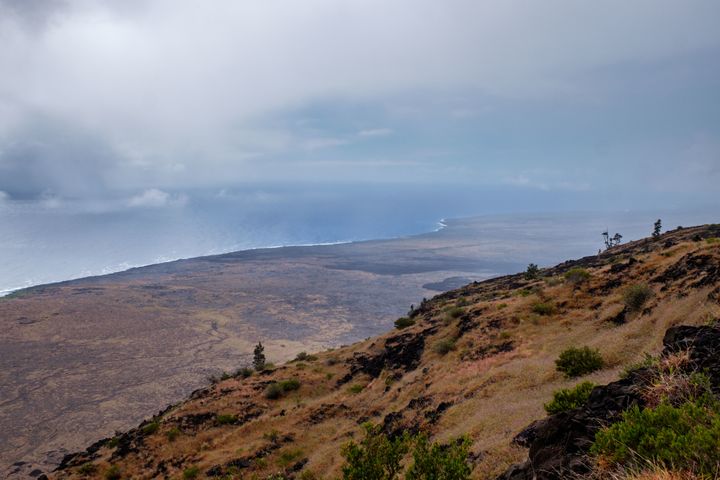
The Hilina Pali Overlook is a cool area to explore that is away from the crowds. Check out that view!
6. Pu’u Loa Petroglyphs – Ancient Hawaiian Petroglyphs
On the Islands of Hawai’i, preserving cultural heritage is one of the most important things in life, and the history is long. Learn more about it on a 1.5-mile round-trip hike to the Pu’u Loa Petroglyphs, a site where Hawaiian elders (kūpuna) once designed beautiful etchings depicting the lives of the native Hawaiian people – an offering to the gods in hopes of a more fruitful life. A very cool stop along the Chain of Craters Road!
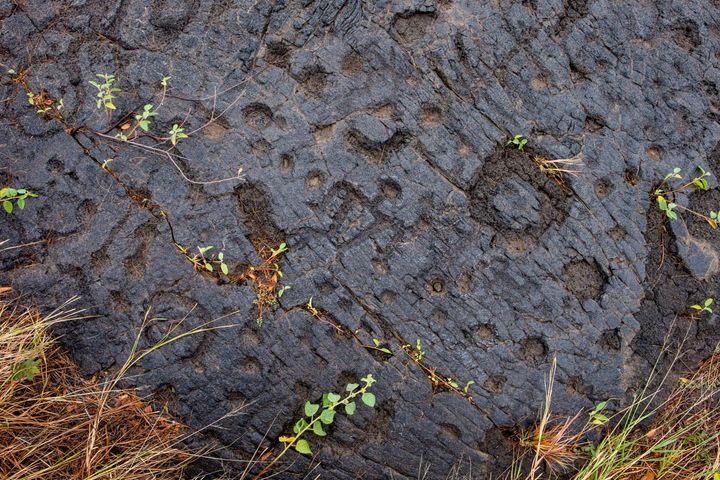
The ancient Pu’u Loa Petroglyphs at Hawai’i Volcanoes National Park
7. Doors-off Helicopter Ride Over The Volcano
This adventure provides an unparalleled overview of Hawai'i Volcanoes National Park. Aerial views of active lava flowing from Kīlauea is a captivating site, and to see it from above with only a seatbelt between you and the bubbling Earth is unimaginably surreal and totally cool! As an added bonus, you get to see gorgeous waterfalls on the way to and from the national park. The trip starts at the Hilo International Airport, from where you will take off to explore the southern coast of the island. This doors-off adventure is harrowing indeed but if you want unobstructed photographs of the volcanic activity on the island, this is your jam. The pilots at Paradise Helicopters were true pros and also provided thoughtful interpretation along the way making it a fully immersive experience.
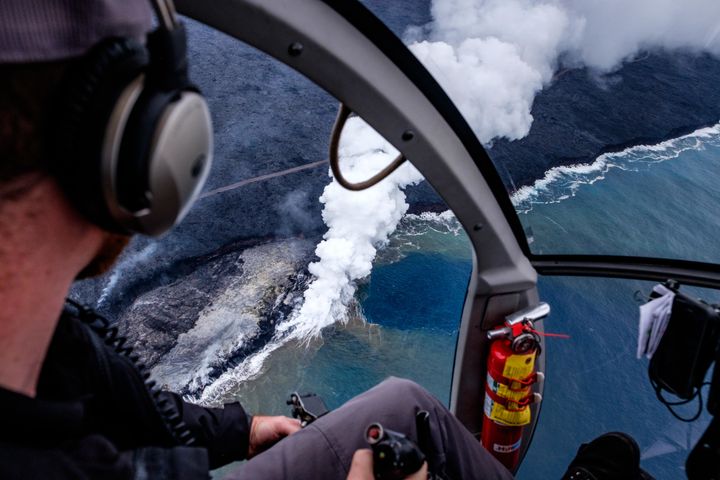
An amazing scene captured from an open-door helicopter while flying above where the Kīlauea volcano meets the largest ocean on Earth—the Pacific!
8. Watch the Lava Meet the Sea!
At the end of Chain of Craters Road, a sublime hike awaits bringing you across an active volcano to a site where lava erupts into the sea. Crossing a hardened lava field with steam rising from its cracks is fascinating by itself, but the real reward is at the end of the 5-mile trek (one way) where you can watch the dramatic result of hot lava connecting with an icy Pacific. Enormous bursts of steam rise into the sky to meet the sunset, rainbows, interesting cloud formations, or whatever other magic is happening in the Hawai'ian sky that day. This is without a doubt one of the most unique hikes in the world – you will instantly feel the power of mother nature (and of Pele) all around you from your very first step.
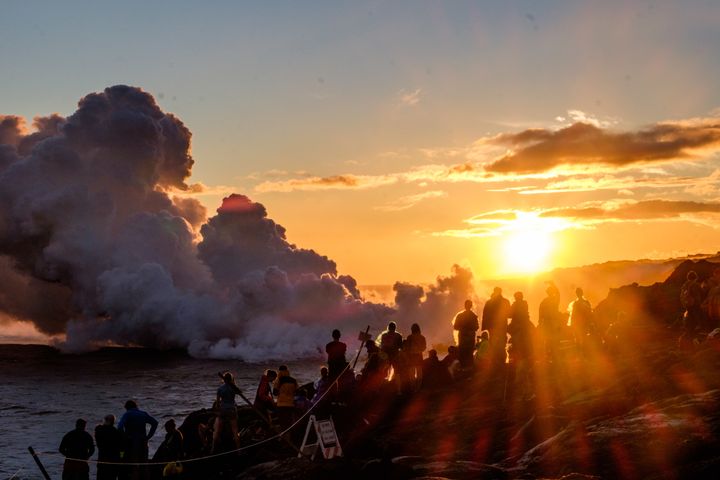
An amazing scene captured from an open-door helicopter while flying above where the Kīlauea volcano meets the largest ocean on Earth—the Pacific!
